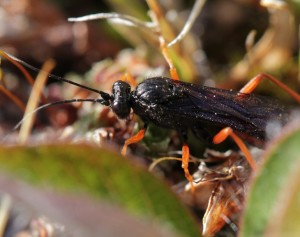Through a unique research collaboration, researchers at the University of Helsinki have exposed major changes taking place in the insect communities of the ArcticDefinitions of the Arctic vary according to environmental, geographical, political, cultural and scientific perspectives. Some scientists define the Arctic as areas having a high latitude, long winters, short, cool summers,... More. Their study reveals how climate changeAccording to the United Nations Framework Convention on Climate Change, climate change is change in the climate of the whole Earth or a region of the Earth that is believed... More is affecting small but important predators of other insects, i.e. parasitoids.
“Predators at the top of the food webA food web is a description of feeding connections in an ecological community (i.e. a group of organisms). Put simply, food webs describe what 'eats' (or more correctly, 'consumes') what.... More give us a clue to what is happening to their prey species, too. These results increase our understanding of how global warmingThe enhanced greenhouse effect due to human activity and the resulting widely accepted rising average temperature near the surface of the Earth since the late 19th century (and its projected... More is changing nature. At the same time, they suggest new inroads for finding answers to big questions in the field of ecology”, says Professor Tomas Roslin from the University of Helsinki and the Swedish University of Agricultural Sciences (SLU).
The researchers’ main discovery was that clear traces of climate changeAccording to the United Nations Framework Convention on Climate Change, climate change is change in the climate of the whole Earth or a region of the Earth that is believed... More can already be seen in arcticDefinitions of the Arctic vary according to environmental, geographical, political, cultural and scientific perspectives. Some scientists define the Arctic as areas having a high latitude, long winters, short, cool summers,... More insect communities.
“In areas where summers are rapidly warming, we find a higher proportion of cold-sensitive predators than we might expect based on the previous climate”, Roslin notes.
The study joined research teams working in Greenland, Canada, Russia, Norway, Finland and Iceland, which together compared regions where the climateThe average weather we would expect over a long period of time (seasons, years, decades). Climate varies from place-to-place across the Earth. Climate is determined by long-term (over at least... More has changed at different rates and in different ways in recent decades.
The research group was supported by INTERACT Trans-National Access.
Read more at the University of Helsinki website.

